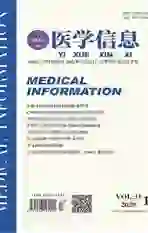Caveolin-1在内毒素性肺损伤所致的肺纤维化中的表达及临床意义
2020-07-27何创王海燕肖建斌高巨闫雪静
何创 王海燕 肖建斌 高巨 闫雪静



摘要:目的 探討小窝蛋白-1(Caveolin-1)在内毒素(LPS)性肺损伤所致的肺纤维化中的表达及临床意义。方法 选择健康雄性SD成年大鼠60只,随机分成对照组、模型组和干预组,各20只。对照组尾静脉注射生理盐水2 ml,模型组、干预组均采用LPS 5 mg/kg以生理盐水稀释至2 ml尾静脉注射,诱导肺损伤纤维化模型,干预组在给予诱导前经尾静脉先给予TGF-β1抗体2 μg/100 g,给药后第1、5、14、21天分别处死每组SD大鼠5只,取大鼠肺组织行HE染色观察病理变化,免疫组化方法检测肺组织内的肺组织胶原蛋白活性(Hpy)、Ⅰ型转移生长因子受体(TβRⅠ)以及Caveolin-1的表达情况。结果 ①对照组肺泡结构基本正常,肺泡腔内无明显渗出及炎症细胞浸润;模型组第1天以急性肺泡炎症为主,第5天时肺泡炎症较前有所减轻,第14天时开始出现肺纤维化,第21天时出现广泛肺纤维化;干预组病理改变与模型组呈同一规律,但肺泡炎症和肺纤维化程度轻于模型组;②给药后第1、5、14、21天,模型组和干预组Hpy表达均高于对照组,干预组第5、9、14天低于模型组,差异有统计学意义(P<0.05);模型组与干预组肺组织TβRⅠ表达均高于对照组,模型组第14、21天高于干预组,差异有统计学意义(P<0.05);模型组与干预组血清Caveolin-1水平低于对照组,且干预组高于模型组,差异有统计学意义(P<0.05)。结论 Caveolin-1可减轻内毒素性肺损伤的程度,并能抑制纤维化过程,具有一定的肺保护作用。
关键词:急性肺损伤;肺纤维化;Ⅰ型转移生长因子受体;小窝蛋白-1
中图分类号:R563.8 文献标识码:A DOI:10.3969/j.issn.1006-1959.2020.13.018
文章编号:1006-1959(2020)13-0065-04
Caveolin-1 Expression and Clinical Significance in Pulmonary Fibrosis Caused
by Endotoxic Lung Injury
HE Chuang1,WANG Hai-yan1,XIAO Jian-bin1,GAO Ju2,YAN Xue-jing3
(1.Department of Anesthesiology,the Second Affiliated Hospital of Guangzhou University of Traditional Chinese Medicine,
Guangzhou 510120,Guangdong,China;
2.Department of Anesthesiology,North Jiangsu People's Hospital,Yangzhou 225000,Jiangsu,China;
3.Department of Breast Cancer,Guangzhou Integrated Traditional Chinese and Western Medicine Hospital,
Guangzhou 510120,Guangdong,China)
Abstract:Objective To investigate the expression and clinical significance of Caveolin-1 in pulmonary fibrosis caused by endotoxin (LPS) lung injury.Methods 60 healthy male male SD rats were randomly divided into control group, model group and intervention group, 20 rats each. The control group was injected with 2 ml of normal saline. The model group and the intervention group were injected with LPS 5 mg/kg diluted with normal saline to 2 ml of the tail vein to induce the lung injury fibrosis model. The intervention group passed the tail vein before induction. TGF-β1 antibody was given 2 μg/100 g, and 5 SD rats in each group were killed on days 1, 5, 14 and 21 after administration. The lung tissues of the rats were taken for HE staining to observe pathological changes and detected by immunohistochemistry Lung tissue collagen activity (Hpy), type Ⅰ transfer growth factor receptor TβRⅠ and Caveolin-1 expression in lung tissue.Results ①The alveolar structure of the control group was basically normal, and there was no obvious exudation and infiltration of inflammatory cells in the alveolar cavity; the model group was dominated by acute alveolar inflammation on the first day, and the alveolar inflammation was lessened on the fifth day than before, and pulmonary fibers began to appear on the 14th day pulmonary fibrosis occurred on the 21st day; the pathological changes of the intervention group were the same as the model group, but the degree of alveolar inflammation and pulmonary fibrosis was lighter than that of the model group;②On days 1, 5, 14, and 21 after administration, the Hpy expression of the model group and the intervention group was higher than that of the control group, and the intervention group was lower than that of the model group on days 5, 9, and 14,the difference was statistically significant (P<0.05); the lung tissue TβRⅠexpression of the model group and the intervention group was higher than that of the control group, and the model group was higher than that of the intervention group on days 14 and 21, the difference was statistically significant (P<0.05); Serum Caveolin-1 levels in the model group and the intervention group were lower than the control group, and the intervention group was higher than the model group,the difference was statistically significant (P<0.05).Conclusion Caveolin-1 can reduce the degree of endotoxin-induced lung injury, and can inhibit the fibrosis process, and has a certain lung protective effect.
Key words:Acute lung injury;Pulmonary fibrosis;Type Ⅰ metastasis growth factor receptor; Caveolin-1
急性肺损伤(acute lung injury,ALI)是临床上常见的急危重症,具有高患病率和高死亡率的特点,一般发病后会伴有多重病理变化,肺部炎性反应失控和肺泡表面活性物质骤降,可导致肺水肿以及肺通气不足,引起二氧化碳蓄积[1]。近年来对信号转导系统的研究发现,位于大多数细胞质膜上约50~100 nm大小的囊性凹陷结构——小窝(caveolae)是许多信号分子完成跨膜信号转导的“驿站”。小窝蛋白(caveolin)是小窝胞浆面包被的一种21~24 kD 的膜蛋白,是多种信号分子活性状态的重要调节者。在无胞外信号刺激下,Caveolin通常与富集于小窝质膜上的各种信号分子、受体及非受体型酪氨酸激酶等相结合,抑制信号物质的活性;在激动剂与受体结合后,Caveolin分子构象发生变构或共价修饰,调节信号物质的活化状态,参与信号转导调控[2]。研究发现,Caveolin-1与Ⅰ型TGF-β1受体(TβRⅠ)及其下游信号蛋白共域化且能与TβRⅠ相互作用[3],而转化生长因子受体(TβRⅠ)能抑制脂多糖诱导大鼠急性肺损伤,有助于降低炎症反应和肺纤维化[4]。基于此,本研究以SD大鼠作为研究对象, 探讨Caveolin-1与转化生长因子受体对脂多糖诱导的大鼠急性肺损伤的抑制作用及对小鼠肺纤维化的影响。
1材料与方法
1.1实验动物及材料 2011年1月在广东省中医院大学城动物实验中学购置SPF级Sprague-Dawley大鼠60只,体重 180~200 g,雄性,3~5月龄,由广东省中医院中心实验室提供(动物实验时间为2011年1~4月)。LPS试剂(美国,Sigma公司),DAB显色试剂盒(博士德生物技术有限公司),TGF beta 1 抗体和Caveolin-1 抗体均购自美国,Santa公司。
1.2造模 将SD大鼠按照随机数字表法分为对照组(C组)、模型组(L组)和干预组(T组),各20只。大鼠用10%水合氯醛(0.4 ml/100 g)腹腔内注射麻醉后,C组经尾静脉给予0.9%生理盐水 2 ml、L组经尾静脉给予脂多糖(LPS)5 mg/kg,T组先经尾静脉给予TGF-β1抗体2 μg/100 g,10 min后再经尾静脉给予脂多糖(LPS)5 mg/kg,生理盐水稀释至2 ml。
1.3标本采集 分别于造模后第1、5、14、21天随机处死对照组、模型组、干预组SD大鼠各5只,水合氯醛麻醉,手术刀片剖开腹腔,钝性分离脏器寻找腹主动脉。采集动脉血3~6 ml肝素抗凝,3500 r/min离心10 min,取上清血浆-70 ℃冻存保存待测;切开胸腔,分离肺,取右肺上叶于10%多聚甲醛中固定,石蜡包埋待测,取右肺中、下叶于-70 ℃冰冻保存制备肺组织匀浆,取左肺叶组织作湿干重比测量。
1.4肺纤维化程度判断 取右肺中下叶组织,用酶联免疫吸附试验(ELISA)测定肺组织中羟脯氨酸(hydroxyproline,Hpy)活性,以反映肺组织中胶原蛋白活性、纤维化程度。
1.5免疫组织化学分析 采用SABC法检测大鼠肺组织TβRⅠ和Caveolin-1,具体操作参照说明书进行。磷酸盐缓冲液(PBs)代替一抗作为阴性对照,染色阳性为棕黄色颗粒。免疫组织化学结果在高倍视野下,每张玻片随机取5个视野,用PIPS-2020高清晰度彩色病理图文分析系统分别测定阳性颗粒的平均吸光度值(A值)。
1.6统计学分析 实验数据用SPSS 17.0软件进行统计学分析。计量资料采用(x±s)表示,多组间比较用单因素方差分析(one-way ANOVA),两两比较用最小显著差异法(LSD法),以P<0.05为差异有统计学意义。
2结果
2.1三组肺组织病理结果比较 对照组各时间点肺泡结构基本完整,肺泡腔内无明显渗出及炎症细胞浸润;模型组第1天时以急性肺泡炎症为主,第5天时肺泡炎症较前有所减轻,第14天时开始出现肺纤维化。第21天时出现广泛肺纤维化,干预组病理改变与模型组呈同一规律,但肺泡炎症和肺纤维化程度轻于模型组,见图1A、图1B。
2.2三组肺组织Hpy水平比较 给药后第1、5、14、21天,模型组和干预组Hpy表达均高于对照组,干预组第5、9、14天低于模型组,差异有统计学意义(P<0.05),见表1。
2.3三组肺组织TβRⅠ表达比较 给药后第1、5、14、21天,模型组与干预组肺组织TβRⅠ表达均高于对照组,且模型组第14、21天高于干预组,差异有统计学意义(P<0.05),见表2。
2.4三组肺组织Caveolin-1表达比较 给药后第1、5、14、21天,模型组与干预组血清Caveolin-1水平均低于对照组,且给药后第5、14、21天干预组高于模型组,差异有统计学意义(P<0.05),见表3。
3讨论
急性肺损伤是临床上最常见的疾病之一,主要由于机体受严重的感染、休克、创伤等原因导致肺组织发生病理变化,引起肺部发生弥漫性渗出、难以纠正的低氧血症等,具有患病率高、病死率高等特点,发病早期如果干预不当或者不及时将会导致急性呼吸窘迫综合征、多器官功能障碍综合征。LPS是内毒素的主要成分,為革兰阴性菌致ALI的主要致病物质,在ALI的体内实验研究中常作为致伤剂建立ALI动物模型。为了更深入地研究ALI,本研究应用LPS致大鼠ALI,观察内毒素性急性肺损伤大鼠肺组织中Caveolin-1的变化。
